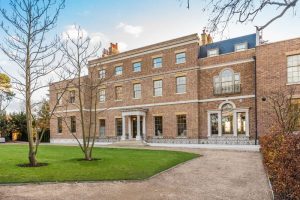
One of the most significant challenges in maintaining the energy efficiency of historic properties is the balance between preserving their unique character and incorporating sustainable technologies. That’s where vacuum glazing steps in as a game-changer.
Vacuum glazing enables the retention of the original appearance of windows in listed buildings, maintaining their historical character. Its slim profile ensures minimal disruption to the original architectural design, allowing the beauty of the structure to shine through.
One of the remarkable advantages of vacuum glazing is its exceptional thermal insulation properties. The vacuum-sealed gap between the glass panes acts as an effective barrier, significantly reducing heat loss and improving energy efficiency. This allows listed buildings to achieve modern standards of thermal performance while keeping their traditional aesthetics intact.
Another notable benefit of vacuum glazing is its ability to reduce noise transmission. Listed buildings often face challenges with external noise, and vacuum glazing can provide a substantial improvement in acoustic insulation. It helps create a peaceful and comfortable indoor environment, allowing occupants to enjoy tranquility while still being connected to the outside world.
By implementing vacuum glazing, listed buildings can significantly reduce their carbon footprint. The improved thermal performance leads to reduced energy consumption for heating and cooling, making these buildings more environmentally friendly. This sustainable approach not only benefits the planet but also helps to lower energy costs and increase long-term financial savings.
One of the biggest challenges to date is meeting regulatory requirements of listed buildings, specifically within the planning sectors. However, vacuum glazing is often considered an acceptable solution due to its minimal impact on the building’s original fabric. By opting for this innovative technology, owners of listed properties can comply with conservation regulations while embracing energy efficiency measures.
If you’re involved in the restoration or maintenance of listed buildings, I encourage you to explore the possibilities of vacuum glazing specifically within our Heritage Range of Timber windows by Gowercroft.
The Winston heritage sliding sash and Richmond heritage flush casement windows were designed to offer a real solution to the competing requirement for aesthetics and energy efficiency in replacing windows in listed and historically important buildings.
The Winston sliding sash and the Richmond casement are pioneering high-tech timber windows, which replicate the appearance of traditional single-glazed windows of the past while delivering exceptional performance. The unique combination of Gowercroft’s traditional joinery, Landvac ultra-thin vacuum glazing, high quality modified Accoya® timber, and the latest in micro-porous paint coatings has produced innovative, high performance windows that offer the best of all worlds: the appearance of the traditional single-glazed windows of yesteryear, modern levels of heat and noise insulation, plus low maintenance, durability, sustainability, and low life-cycle costs.
Whole window U-values are better than standard double-glazed timber windows, surpassing Part L building regulation requirements for new build properties. For example, a Winston sliding sash window of 1230mm x 1480mm, would have a whole window U-value below 1.35W/m². An example Richmond two-light casement window of 1480mm x 1230mm, would have a whole window U-value below 1.40W/m². This is achievable partly because the molecular structure of Accoya® naturally traps air, making it is a better insulator than hardwoods and softwoods. The Winston sliding sash window also includes Gowercroft’s patented SashSealer technology, which achieves BSI Class 4 air permeability standards.
A full 10-year guarantee applies to all elements of the window. The window is also fully eligible for a lifetime guarantee under our TimbaCare serviced maintenance programme. Accoya® acetylated wood has the best longevity of any timber on the market. Furthermore, the raw timber is class 1 durability-rated and has a 70-year minimum service life (TRADA). The windows are fully factory finished with a micro-porous paint system (performance tested with Qv equipment) and specially formulated for Gowercroft in order to deliver an exceptional quality of finish, longevity and ultra-low maintenance.
These products have already been specified on several Grade II listed properties, including Winston Churchill’s former home. The Richmond and Winston windows are set to seriously extend the market potential of ultra slim-line windows particularly in the heritage market.
If you have an upcoming project and would like further information, get in touch via our website www.southfield-windows.com or emails us at windows@southfieldgroup.co.uk or call on 01803 866955.